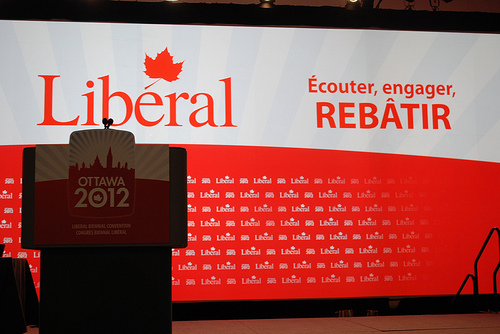There is nothing like a leadership contest to fire up a political party. Choosing a new leader can redefine a party, help it change the public mood, and romp to power. That is what happened when the Liberals elected Pierre Trudeau leader in 1968, and the federal party has been trying ever since to do it again.
Currently, three Liberal parties (each with its own identity and history) are running simultaneous leadership contests: in Quebec, Ontario, and federally. As a result, the Liberals suffer from political organizing overload — campaigns in Ontario and Quebec have practical problems getting campaign workers, and finding financial backing with a federal leadership contest occurring at the same time.
Grabbing public attention for each race is what matters most to party officials. Can the Liberal party do this three times in the next months? Well, yes.
The race in Ontario is about who gets to be the next premier, so considerable interest is guaranteed. Dalton McGuinty leaves his party in poor shape however. Not only is the Liberal minority government struggling in the polls, the new leader will have to explain how the government blew hundreds of millions of dollars on failed gas plant projects, and why it was a good idea to shut down the legislature instead of answering to the people about his conduct of public affairs.
In Quebec, Liberals are the official opposition — across the aisle from a minority PQ government — so an election looms. Unhappily for the party, the public is most interested in what role the Liberals played in the construction industry scandals currently under investigation by the Charboneau commission, and playing to a huge audience. So far, revelations have focused on the business practices of kickbacks to municipal employees. Provincial practices are going to be discussed, and are sure to intrude in the leadership race.
The federal Liberals have the pre-eminent candidate the other two are missing. Maclean’s called Justin Trudeau “the most popular politician in Canada,” and ran a photo spread of the young father with his family, and of Trudeau growing up at 24 Sussex Dr., a place he wants to re-occupy.
As third party in the House of Commons, and with no election expected before October 2015, the outcome of the federal race has no immediate impact on the political situation in Ottawa. People are going to watch the race closely anyway — if only to see how Justin does.
All leadership candidates in the three races will be judged by their ability to explain where we are at as Quebecers, Ontarians, or Canadians, and what needs to be done next.
Liberals like to portray themselves as minders of the “middle class.” This role gets more difficult to sustain as the class war deepens, and as Liberals (especially in Quebec and Ottawa) are fighting for the big business side.
Photo: Andrew Reeves/Flickr
Think of Canadians lined up according to income, from highest to lowest. In the postwar years when the federal Liberals were mostly government, about 80 per cent of Canadians went out to vote. Party organizers figured that most of those not voting were among the poorest 20 per cent by income. The top 20 per cent were not numerous enough to decide an election outcome. That left the middle 60 per cent (labelled the middle class). Provide a family allowance cheque, unemployment insurance, a pension, low tuition, eventually health care, and secure support from middle-income earners.
With the rise of the Reagan-Thatcher neo-conservative right in the 1980s, figures like Brian Mulroney, Mike Harris, and Ralph Klein successfully demonized government and politics. They were so successful the voter turnout dropped to the 60 per cent range.
The recipe followed by Liberals and Conservatives alike was to continue to forget about the bottom 20 per cent, but now concentrate on securing support from the top 40 per cent, and wannabe top income earners from below. Provide lower taxes, dump on the public service, privatize, de-regulate, and empower big business.
These policies succeeded in increasing inequalities, and creating a super rich group, the fabled top 1 per cent of the top 1 per cent. Most Canadians saw no income benefits, a reduced quality of life with fewer public services, and experienced increased anxieties about the future. Middle-income angst is real, income prospects have dimmed, and belief in both government and business has waned.
All three Liberal parties want to choose a winner for leader. In order to fire up Quebecers, Ontarians, or Canadians, those leaders are going to have to find a way to put their parties in contact with a suspicious voting public. Lining up with big business is not going to win hearts and minds. Camouflaging support for more of the same is unlikely to fool enough voters in Ontario and Quebec to make a difference in future election outcomes.
Each of the three Liberal parties needs to redefine itself and what it stands for, not just find a new leader.
Duncan Cameron is the president of rabble.ca and writes a weekly column on politics and current affairs.




